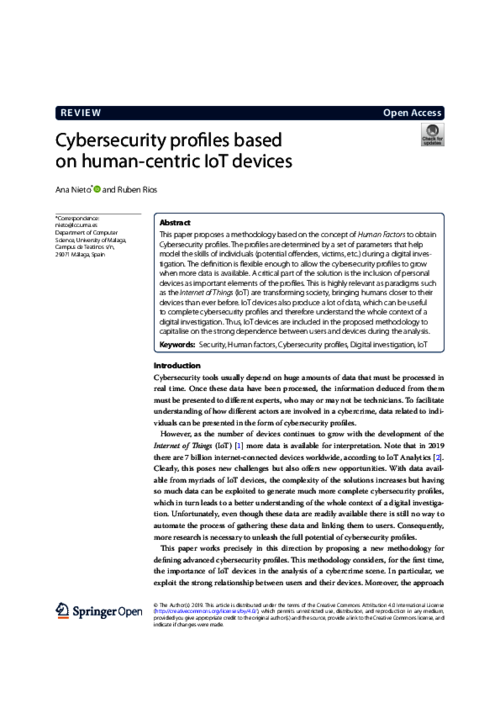 ] Type Year
] Type Year XIV Reunión Española sobre Criptología y Seguridad de la Información, pp. 168-173, 10/2016.
Abstract
En la Internet de los Objetos (IoT, por sus siglas en inglés), los ataques pueden ser perpetrados desde dispositivos que enmascaran su rastro ayudándose de la densidad de objetos y usuarios. Actualmente la idea de que los dispositivos de usuario almacenan evidencias que pueden ser muy valiosas para frenar ataques es bien conocida. Sin embargo, la colaboración de éstos para denunciar posibles abusos telemáticos aún está por definir. Los testigos digitales son dispositivos concebidos para definir la participación de dispositivos de usuario en una cadena de custodia digital. La idea es que las evidencias se generan, almacenan y transfieren siguiendo los requisitos marcados por las normas actuales (p.ej. UNE 71505), pero respetando las restricciones en recursos de los dispositivos. En este artículo proponemos una arquitectura funcional para la implementación del concepto de testigo digital en dispositivos heterogéneos de la IoT.
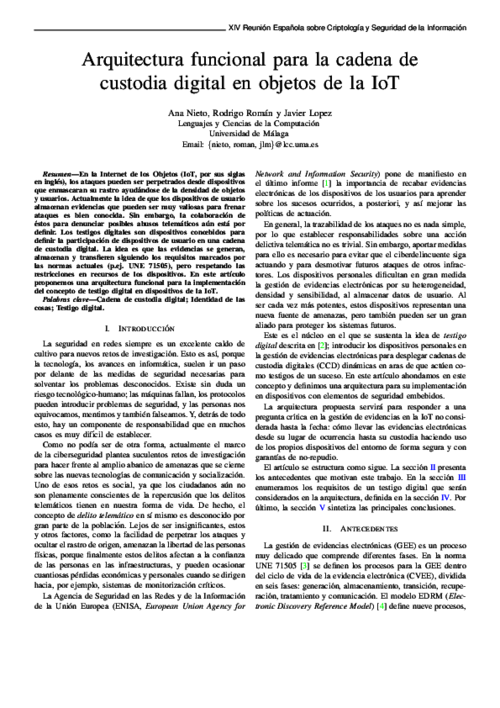
IEEE Transactions on Information Forensics & Security, vol. 15, IEEE, pp. 3325-3334, 17/04/2020. DOI
Abstract
One of the biggest challenges in IoT-forensics is the analysis and correlation of heterogeneous digital evidence, to enable an effective understanding of complex scenarios. This paper defines a methodology for extracting unique objects (e.g., representing users or devices) from the files of a case, defining the context of the digital investigation and increasing the knowledge progressively, using additional files from the case (e.g. network captures). The solution includes external searches using open source intelligence (OSINT) sources when needed. In order to illustrate this approach, the proposed methodology is implemented in the JSON Users and Devices analysis (JUDAS) tool, which is able to generate the context from JSON files, complete it, and show the whole context using dynamic graphs. The approach is validated using the files in an IoT-Forensic digital investigation where an important set of potential digital evidence extracted from Amazon’s Alexa Cloud is analysed.
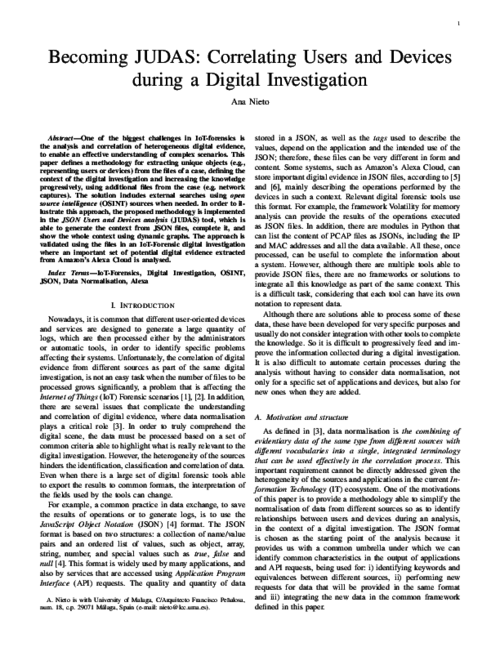
XVII Reunión Española sobre Criptología y Seguridad de la Información, pp. 168-173, 11/2022.
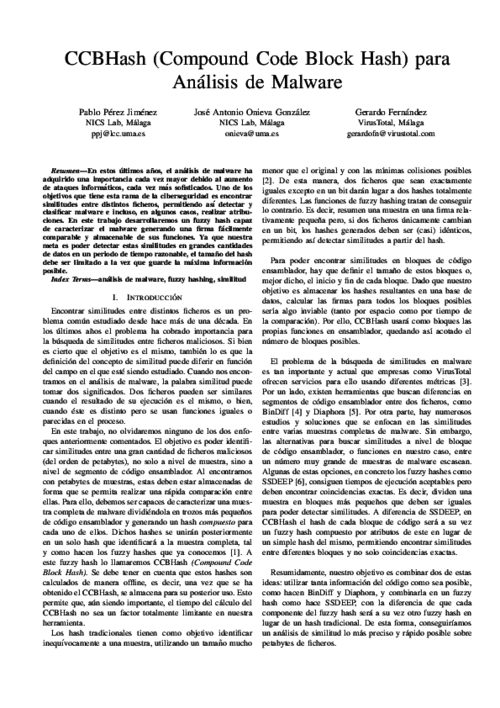
15th International Conference on Trust, Privacy and Security in Digital Business (TrustBus 2018), vol. LNCS 11033, Springer Nature Switzerland AG, pp. 229–243, 09/2018. DOI
Abstract
Recent news have raised concern regarding the security on the IoT field. Vulnerabilities in devices are arising and honeypots are an excellent way to cope with this problem. In this work, current solutions for honeypots in the IoT context, and other solutions adaptable to it are analyzed in order to set the basis for a methodology that allows deployment of IoT honeypot.
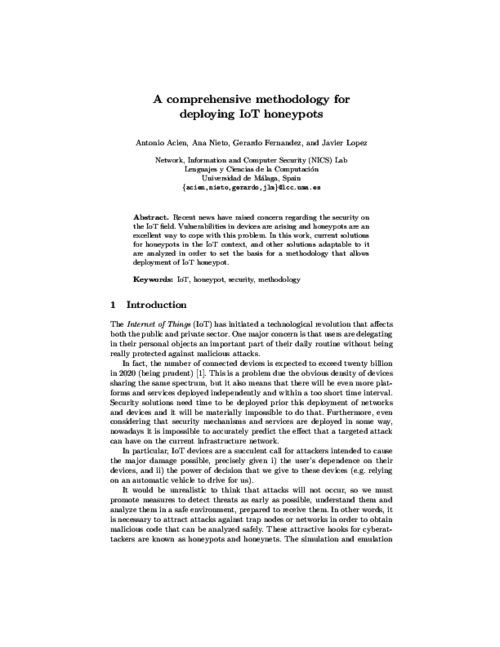
Human-centric Computing and Information Sciences, vol. 9, no. 1, Springer, pp. 1-23, 2019. DOI
XV Reunión Española sobre Criptología y Seguridad de la Información, 10/2018.
Abstract
Con la revolución tecnológica que ha supuesto la Internet de las Cosas (Internet of Things, IoT) se han presentado escenarios donde la preocupación por la seguridad en dicho entorno es cada vez más relevante. Están comenzando a surgir vulnerabilidades en varios dispositivos, y los sistemas trampa son una excelente manera de lidiar con este problema. En este trabajo se analizan soluciones para honeypots en el entorno IoT (y en otros que se puedan adaptar) para sentar las bases de una metodología que permita el despliegue de honeypots IoT.

16th IEEE International Conference On Trust, Security And Privacy In Computing And Communications (TrustCom 2017), IEEE, pp. 642-649, 08/2017. DOI
Abstract
The digital witness approach defines the collaboration between IoT devices - from wearables to vehicles - to provide digital evidence through a Digital Chain of Custody to an authorised entity. As one of the cores of the digital witness, binding credentials unequivocally identify the user behind the digital witness. The objective of this article is to perform a critical analysis of the digital witness approach from the perspective of privacy, and to propose solutions that help include some notions of privacy in the scheme (for those cases where it is possible). In addition, digital anonymous witnessing as a tradeoff mechanism between the original approach and privacy requirements is proposed. This is a clear challenge in this context given the restriction that the identities of the links in the digital chain of custody should be known.
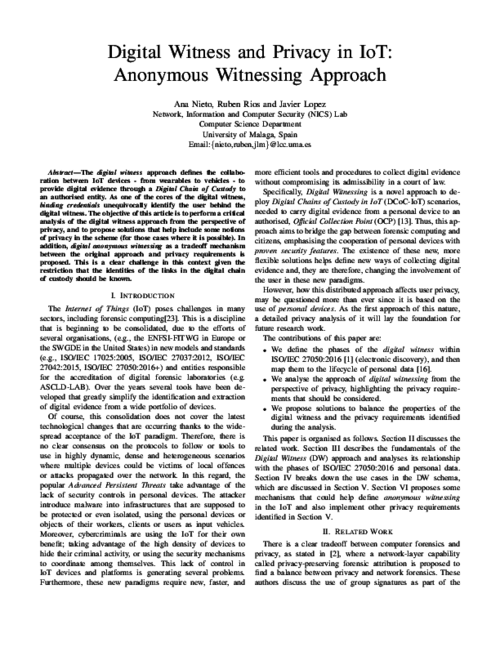
ERCIM News, no. 106, ERCIM EEIG, pp. 9-9, 07/2016.
IEEE Network, IEEE Communications Society, pp. 12-19, 2016. DOI
Abstract
Personal devices contain electronic evidence associated with the behaviour of their owners and other devices in their environment, which can help clarify the facts of a cyber-crime scene. These devices are usually analysed as containers of proof. However, it is possible to harness the boom of personal devices to define the concept of digital witnesses, where personal devices are able to actively acquire, store, and transmit digital evidence to an authorised entity, reliably and securely. This article introduces this novel concept, providing a preliminary analysis on the management of digital evidence and the technologies that can be used to implement it with security guarantees in IoT environments. Moreover, the basic building blocks of a digital witness are defined.
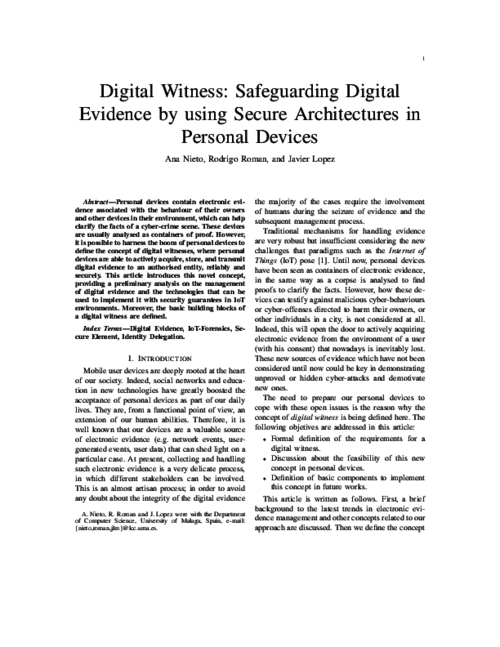
Sensors, vol. 18, issue 2, no. 492, MDPI, 02/2018. DOI
Abstract
IoT-Forensics is a novel paradigm for the acquisition of electronic evidence whose operation is conditioned by the peculiarities of the Internet of Things (IoT) context. As a branch of computer forensics, this discipline respects the most basic forensic principles of preservation, traceability, documentation, and authorization. The digital witness approach also promotes such principles in the context of the IoT while allowing personal devices to cooperate in digital investigations by voluntarily providing electronic evidence to the authorities. However, this solution is highly dependent on the willingness of citizens to collaborate and they may be reluctant to do so if the sensitive information within their personal devices is not sufficiently protected when shared with the investigators. In this paper, we provide the digital witness approach with a methodology that enables citizens to share their data with some privacy guarantees. We apply the PRoFIT methodology, originally defined for IoT-Forensics environments, to the digital witness approach in order to unleash its full potential. Finally, we show the feasibility of a PRoFIT-compliant digital witness with two use cases.
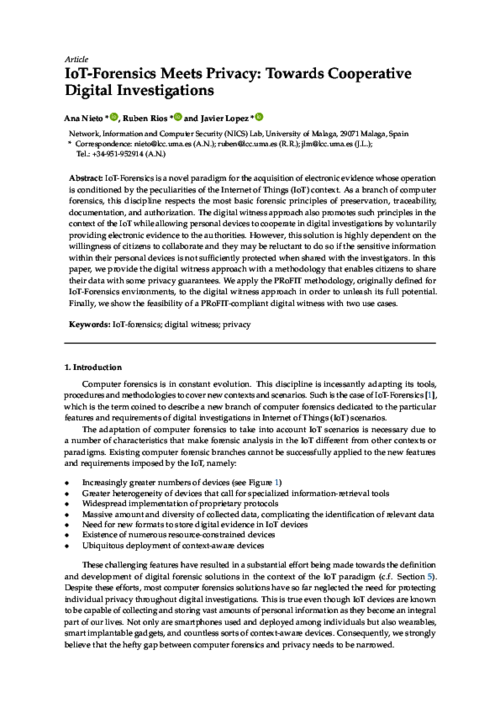
16th IEEE International Conference On Trust, Security And Privacy In Computing And Communications (TrustCom 2017), IEEE, pp. 626-633, 08/2017. DOI
Abstract
The Internet of Things (IoT) brings new challenges to digital forensics. Given the number and heterogeneity of devices in such scenarios, it bring extremely difficult to carry out investigations without the cooperation of individuals. Even if they are not directly involved in the offense, their devices can yield digital evidence that might provide useful clarification in an investigation. However, when providing such evidence they may leak sensitive personal information. This paper proposes PRoFIT; a new model for IoT-forensics that takes privacy into consideration by incorporating the requirements of ISO/IEC 29100:2011 throughout the investigation life cycle. PRoFIT is intended to lay the groundwork for the voluntary cooperation of individuals in cyber crime investigations.
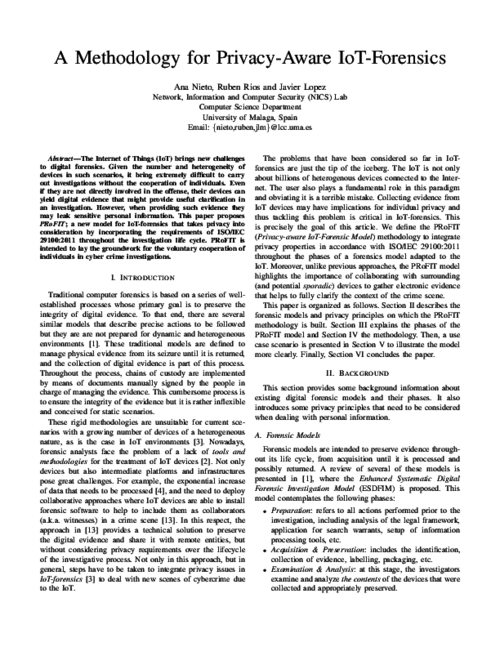
IEEE 5G World Forum (5GWF), IEEE, pp. 191-196, 07/2018. DOI
Abstract
This article analyses the state of the art of proactive forensic solutions and highlights the importance of preparing the 5G ecosystem to serve digital forensic purposes. The analysis considers the current 5G threat landscape from the ENISA report, and discusses how some of the attacks could be mitigated using proactive forensic mechanisms. In addition, the requirements for deploying proactive forensic solutions in 5G are classified, and analysed based on the specific threats against 5G.
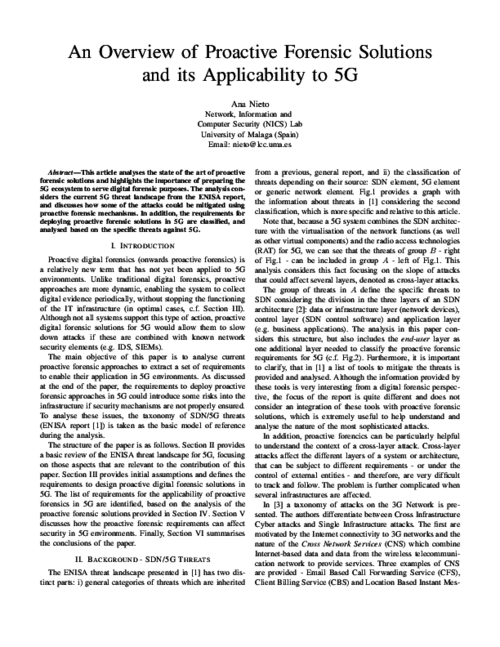
Security and Privacy for Big Data, Cloud Computing and Applications, Lizhe Wang, Wei Ren, Raymoond Choo and Fatos Xhafa, The Institution of Engineering and Technology (IET) , 09/2019.
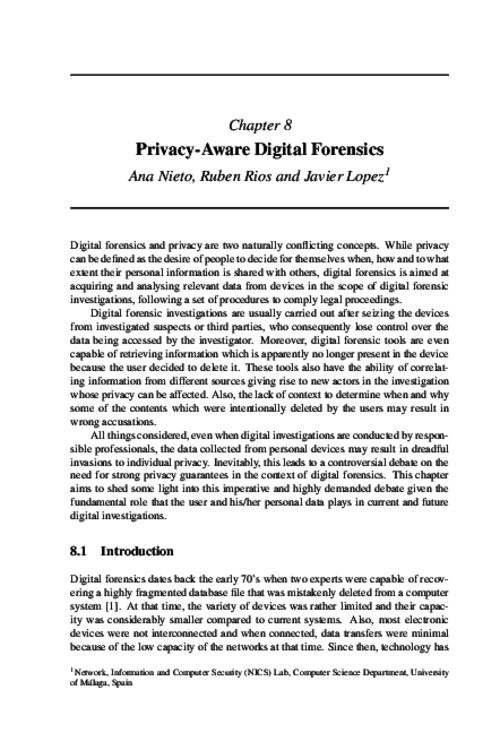
III Jornadas Nacionales de Investigación en Ciberseguridad (JNIC 2017), vol. Actas del JNIC 2017, Servicio de Publicaciones de la URJC, pp. 51-58, 2017.
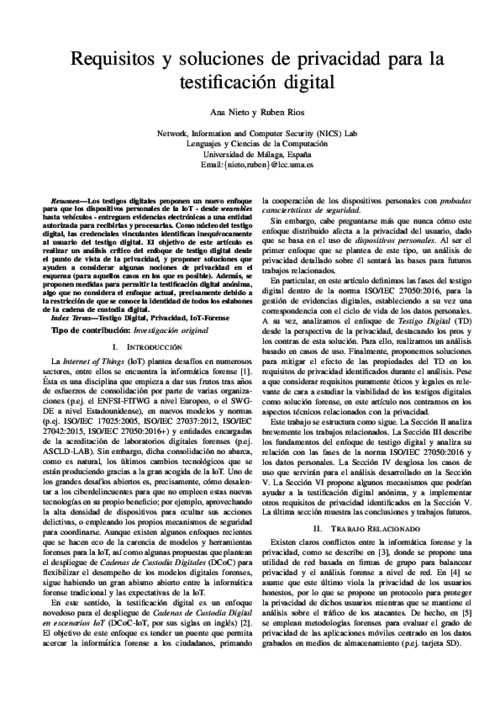
Revista SIC, vol. 122, Ediciones CODA, pp. 94-98, Nov 2016.
Abstract
El creciente número de dispositivos interconectados trae consigo problemas de seguridad bien conocidos; por ejemplo, aquellos debidos a las vulnerabilidades en protocolos muy diversos –muchos de ellos propietarios– y al factor de error humano introducido por los usuarios. Sin embargo, cabe preguntarse cómo podemos usar el despliegue de tales dispositivos en beneficio de la ciberseguridad. En el proyecto IoTest se está desarrollando una solución, el Testigo Digital, que permitirá a los dispositivos personales con arquitectura de seguridad embebida reaccionar ante ataques virtuales, protegiéndonos de los ciberataques emergentes.
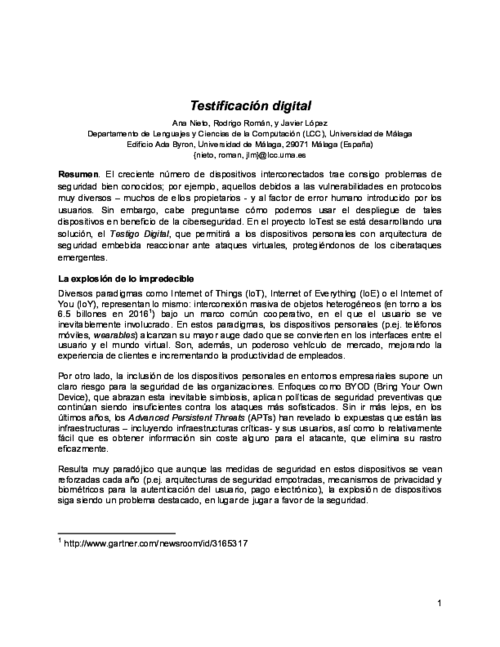
II Jornadas Nacionales de Investigación en Ciberseguridad (JNIC 2016), pp. 109-116, 06/2016.
Abstract
En un mundo en el que los usuarios dependen cada vez más de sus dispositivos, éstos almacenan gran cantidad de datos y son una fuente muy valiosa de información sobre su entorno. Sin embargo, la heterogeneidad y la densidad de los objetos conectados, características propias de la Internet de las Cosas (IoT), sirven de velo para ocultar conductas maliciosas que afectan a estos dispositivos, sin que quede rastro de tales acciones. En este artículo definimos el concepto de testigo digital: funcionalidad que permitirá a los dispositivos personales y otros objetos colaborar para implementar una cadena de custodia digital en la IoT. El fin perseguido es ofrecer soluciones que mitiguen los efectos de la ciberdelincuencia, amparándose en la colaboración de los dispositivos con arquitecturas de seguridad embebidas para alertar de conductas maliciosas, y dejar constancia de éstas.
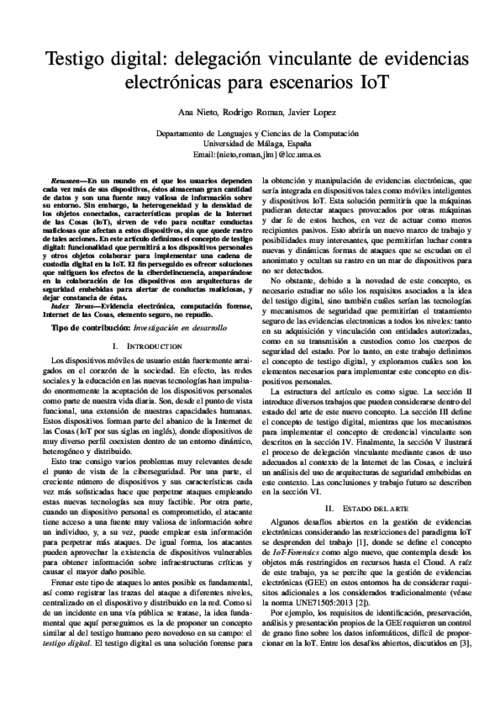
España, C. Autón./Reg. de explotación: Andalucía, Invention Patent, vol. P201500764, G06F 21/00, 10/2015.
